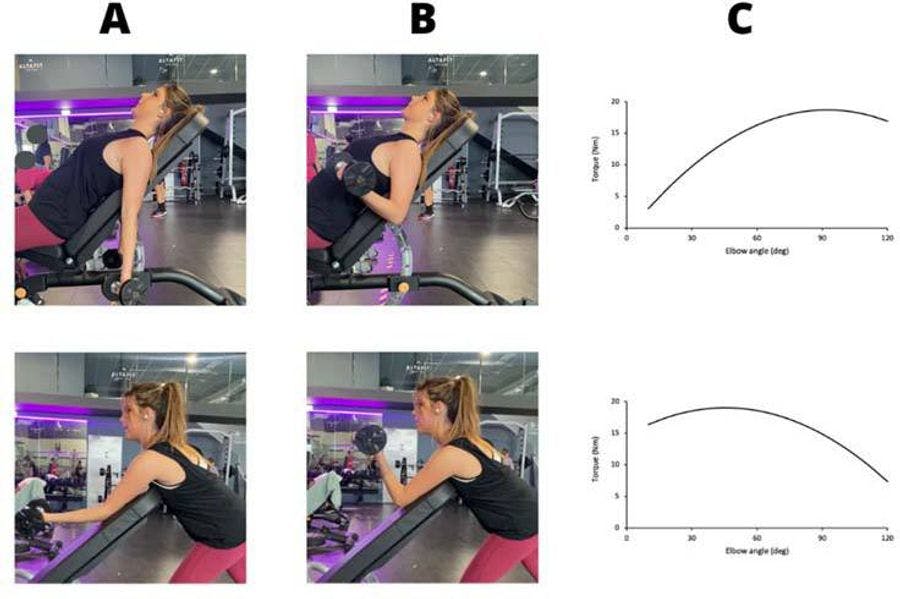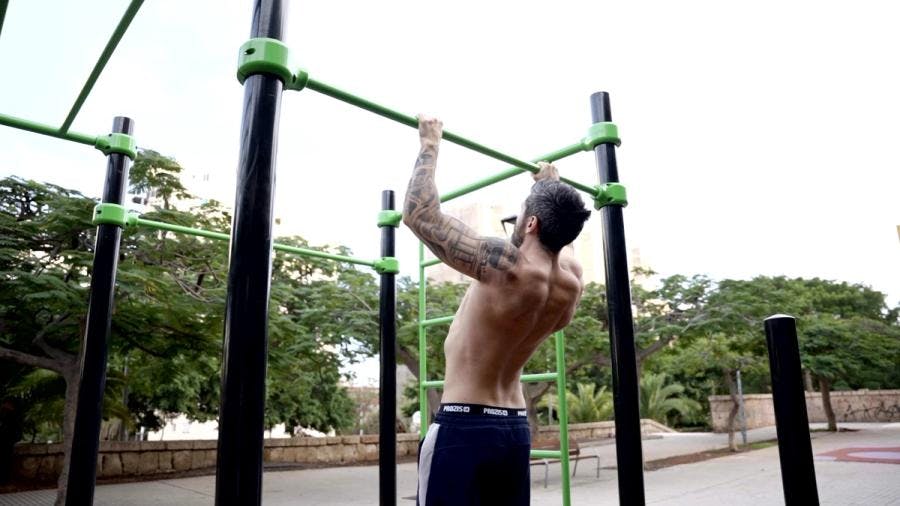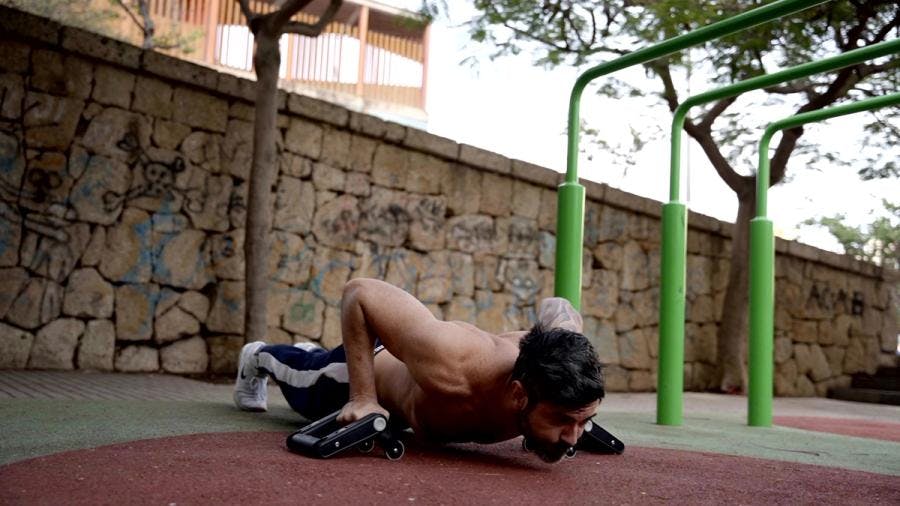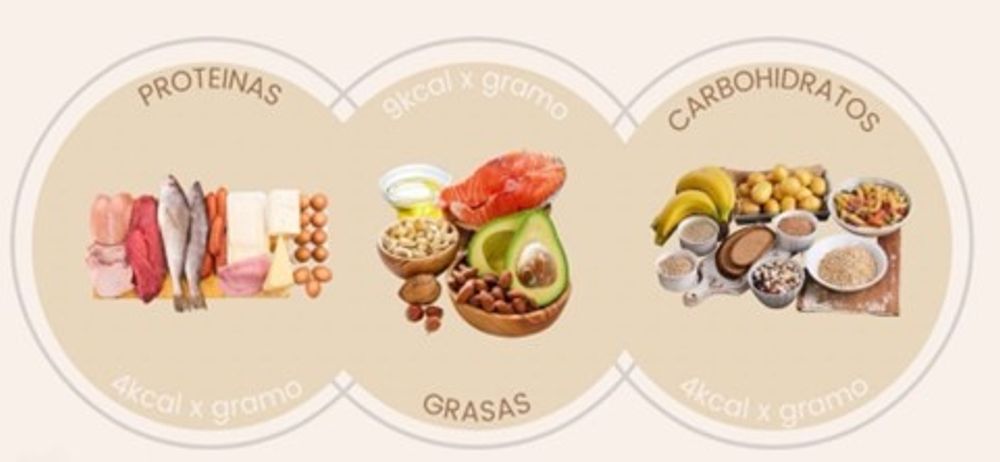
Calisthenics for beginners: exercises and routine
Calisthenics routines for beginners, exercises by level, and complete workout to progress safely and effectively.

Several recent studies have sparked controversy since they seem to indicate that partial range repetitions are better for hypertrophy, for building muscle, than the full range of motion.
In this article we're going to look at what those studies say exactly, how to apply them in your workouts, and how this affects the whole topic of full range of motion in calisthenics.
To analyze this topic, we are going to review the results of several studies, the first of which is this one from 2021, in which hypertrophy on the leg was compared after weeks of doing seated femoral curls with one leg versus lying femoral curls with the other.
At the end of the study, the muscle volume of the hamstrings increased by 14% in the leg that curled seated versus only 9% in the leg that curled lying down.
According to the authors, this seems to indicate that training the muscle in a greater stretch is beneficial in hypertrophy, since in the seated curl the hip is flexed and this causes the hamstrings to be more stretched in the initial position.

These results seem to have led the authors to continue researching the topic and conduct another study in 2023 in which they compared triceps growth using overhead pulley extensions with one arm versus the neutral position with the other. And indeed the growth was significantly greater in the arm that did the extensions in the overhead position, coinciding again with the fact that it is the version in which the muscle is in a more elongated position, compared to the neutral extensions.
The third study that we will analyze is this one from 2023, in which biceps training was compared with preacher curls vs. incline curl.
The results showed a greater increase in muscle mass with the preacher curl, specifically in the distal area, the area closest to the elbow. The increase in muscle mass with the incline curl was so slight that it was not statistically significant.
The interpretation that we can obtain from this result is that it may be due to the fact that the preacher curl has greater work intensity in the part in which the biceps is elongated, as shown by its resistance profile, while in the inclined curl that part of the movement It's less intense.

And finally the last study is this one that compared the muscle damage received in people who did partial range biceps curls in the elongated zone, compared to people who did partial range biceps curls in the part of the movement in which the biceps is more contracted. The result was that the biceps received more muscle damage in the arm that did the extended partial range.
I had to add one last study as a bonus track that I think is very important. I didn't know about it because it came out only a few months ago, but it changes the perspective and the conclusions we can draw a lot.
In this study with 42 participants, they were divided into groups to train calf raises with different ranges of motion, one group did full range, the other did partial range in the shortened part, and the third group did partial range in the lengthened part. Well, after 8 weeks it was seen that the group that had gained the greatest hypertrophy in the calf was the group with partial range in the elongated part, followed by the group with full range and finally the group with shortened partial range.
From what I've seen online, it seems that these results led some people to conclude that it is better for hypertrophy to train doing partial range, focusing on the part where the target muscle is most elongated. For example, do cable pulldowns or partial range pull-ups focusing on the part of the movement in which the lats and biceps are most elongated.

I believe that this is clearly an error, since of all the studies we have seen, only the last one, that of the calves, is the one that can lead to that conclusion.
The one about the partial range in the biceps curl could also point in that direction, but in that case we cannot draw the conclusion that the elongated partial range is better for hypertrophy with respect to the full range, since that was not compared in this study. It was only compared against the contracted partial range. Furthermore, what was seen was that greater muscle damage was produced, but it was not analyzed whether greater hypertrophy was produced. And, although it is true that muscle damage is a precursor to hypertrophy, it is not the only factor for it, so it would have been better for those of us who are interested in the topic of hypertrophy if the study analyzed the muscle growth of each arm, not muscle damage.
In the rest of the studies there was no comparison between partial ranges and complete ranges, only different exercises in which the muscle was more or less elongated were compared.
I think what we can conclude is, first of all, that when faced with two exercises that work the same muscle, in order to achieve greater muscle growth, everything seems to indicate that the exercise that achieves greater elongation of the muscle in question is better. Furthermore, if the exercises have different resistance profiles, it seems that the one with a higher intensity in the part where the muscle is elongated will give better results.

The second conclusion we can draw is that there are indications that, for a pure hypertrophy goal, it is possible that a partial range with the muscle at its greatest extension may be better than a full range. But at the moment we only have one study that indicates this and with a single muscle, so we will need to wait for more work on the matter.
Previously, the differences between partial range and full range have been studied in several meta-analyses, but from what I have seen, this issue of muscle elongation has not been specified, and, in that case, the full range has won.
Furthermore, it is important to note that with respect to strength, it does seem that the evidence clearly indicates that the full range is better than the partial range.
For those of us who train calisthenics, I think the first thing we can do is look for a wider range of motion in exercises such as dips, push-ups or most leg exercises, since in this way we will achieve greater elongation of the muscle during the exercise

Obviously, this increases the difficulty of each of the exercises, so you should always adapt the work to your current ability and level. It also seems clear to understand that if you are looking for hypertrophy in pull-ups you must fully extend your arm, as I recommended in my article on the perfect pull-up.
But I don't think we should seek to make a partial range, since the studies still don't really give us a clear conclusion on this. Even so, if our only option was to do partial range, there are indications that for muscle growth the part of the range in which the target muscle has greater extension would be better.
As we can see, at the moment it is not clear that the partial range is better than the full range, and in any case it would only be for a pure hypertrophy objective, since for strength we can say that the full range is better. In any case, I think that a good strategy would be to look for an even more complete range, for example looking for greater depth in dips, push-ups, handstand push-ups or leg exercises, since this way we would have the benefit of working with the muscle to greater extent, and full range strength benefits.

As we have already commented in other articles, one of the main values of calisthenics is the taste for strict technique, and I think that, even if we want to focus on greater hypertrophy, for the moment it would be premature to give it up. Additionally, in calisthenics our progress depends a lot on our relative strength, so giving up the full range would take away a lot in that regard.
We are going to move on to the conclusions to summarize everything we have learned in this video, but first remind you that another extra that you can use for hypertrophy is supplementation, specifically I would recommend using protein and creatine. You can get it at Prozis.com using the code YERAI for a 10% discount, gifts per order quantity and points that can be accumulated and redeemable for more gifts.
Also let you know that at Calisteniapp we are already starting the 21-day challenge at the beginning of the year, in which we are going to do 21 days of short, high-intensity routines to start 2024 with discipline and focused on training. You can use them as a complement to your usual routine or dedicate yourself 100% to the challenge according to your preferences. Now let's go to the conclusions.
To close and summarize, recent evidence tells us that if we want to maximize the growth of a specific muscle, we must try to work it to the greatest extension possible, either with specific exercises that allow this greater extension or by increasing the range of motion of a specific exercise. There is also some preliminary indication that for a pure hypertrophy goal, a partial range in the extended part of the muscle may be better, but more evidence is needed on this.

Yerai Alonso
Cofundador de Calisteniapp, referente en calistenia y el street workout en Español. Con más de una década de experiencia, es creador de uno de los canales de YouTube más influyentes del sector. Autor del libro La calle es tu gimnasio, campeón de Canarias y jurado en competiciones nacionales e internacionales.
Join our newsletter
Learn everything you need to know about calisthenics

Calisthenics routines for beginners, exercises by level, and complete workout to progress safely and effectively.

Learn all about macronutrients: their roles, types, and the importance of nutrient timing for sports performance. Read our complete guide for athletes.

Not sure what to eat before training calisthenics? In this article, we explain the ideal pre-workout nutrition based on your specific type of training session.
